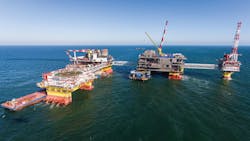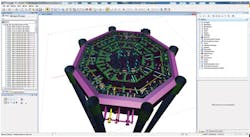Information management system assists V.Filanovsky construction process
Software can be redeployed on other Caspian fields
Jeremy Beckman
Editor, Europe
Production is ramping up from Lukoil’s V.Filanovsky field in the Russian sector of the Caspian Sea which came onstream in October. The phased development, in 7-11 m (23-36 ft) of water, currently comprises a 15,200-ton ice-resistant fixed platform (IRFP-1); a living quarter module platform (LQM-1); a 21,000-ton central processing platform (CPP); and a riser block platform (RB), linked by bridges. The second phase of development will add the IRFP-2 and LQM-2 platforms.
IRFP-1 is used for drilling and operation of wells while the CPP processes the wellstream and exports the oil and gas to shore via pipelines. The RB platform connects the infield pipelines with the export pipelines. All the platforms are also connected via pipelines to infrastructure serving Lukoil’s producing Yuri Korchagin offshore field.
Among the main offshore construction contractors, United Shipbuilding supplied the IRFP-1, Globalstroy Engineering the CPP, and Krsanye Barrikady Shipyard LQM-1 and RB, with Saipem transporting and installing the facilities and laying the two 114-km (71-mi) export pipelines from the RB to the shore landfall, using theCastoro 12 and Castoro 16 barges. Bumi Armada laid the interfield flowlines.
LLV Volgogradnefteproekt in Volgograd was tasked with preparing documentation in 2D and 3D for each platform structure. The six main contractors working on the platforms employed different software (AVEVA, Autodesk, Bentley, Tribon). LLV Volgogradnefteproject’s role was to consolidate all engineering work from the different contractors and to tie the data into an information model, with subsequent submission to Lukoil in an ‘as-built’ format. The aim was to deliver a complex information model of the field that would correspond with the actual end-product, to assist the client with management and engineering at all stages of the project.
According to LLV Vologradbefteprojekt chief engineer V.V. Kalinin, speaking at the recent Bentley Year in Infrastructure conference in London, the company worked jointly with Bentley on developing the engineering data management system (EDMS) for the offshore facilities, using Open Plant and PRO STEEL software for the design.
The purpose of the EDMS, Kalinin said, was control and monitoring of the facilities during each stage of the project. “First we developed an information model, then imported this into Bentley’s Asset-wise platform along with 3D models that had been developed for the facilities. The system was then ready to control and supervise construction and installation works.” The company subsequently expanded the system to duties such as development of documents, procurement of equipment, trials, tests and commissioning; and also inspection and supervision of equipment parameters, and ensuring compliance with all required Russian verification certificates. “The 3D models, work plan, timetable and reports on the current state of affairs were all compressed into a single system using the Asset-Wise platform,” Kalinin added.
For the IRFP-1, 100 3D models were developed covering different elements of the drilling platform (which contains over 10,000 items of equipment), including control desks, steel structures, and reinforcements. “Our system envisages over 100,000 control and instrumentation operations,” Kalinin said, “and among other things has to manage over 10,000 different documents provided by the various contractors - and this is just for one platform.”
Kalinin notes that all the data is integrated and interconnected, allowing the user to navigate the system. “Clicking on one equipment item takes you to a 3D model with a description and specifications of that item, along with the completed work performed on that item.” The system is very intuitive, he continued, also providing access to documentation from the manufacturer of each piece of equipment, listing the different construction operations that may need to be performed using this equipment, and displaying to the user which certificates and approvals are needed to use the equipment.
For each stage of the project’s implementation, Kalinin said, the EDMS provides a separate information model containing a list and capacities of equipment items, and data can be imported into the system to allow the user to perform analyses of or to obtain reports on the current state of the facility - “showing you what is actually happening as opposed to what was planned.” In addition, all design documentation from the seven platforms can be uploaded to the EDMS, Kalinin said, for use in controlling procurement, construction, and other tasks at a later date.
“The system’s efficiency has allowed us to control all aspects of construction at each phase, and also to manage all changes to the facility and assess the impact of those changes on operation of the facility. It has improved quality and design engineering, the time spent on construction, and optimized the allocation of resources.”
Kalinin claimed the system had led to a 30-50% saving in time and resources: “We have achieved this through synchronizing procurement schedules, and performing pre-installation inspection of equipment…and through providing a detailed description of all construction and installation works for all types of equipment along with the sequence of operations that have to be performed in each case.” Incoming equipment data from the different contractors assembled using different software that does not comply with Bentley’s requirements is converted to a Bentley-compatible format. “We have also developed a set of standards that our contractors have to meet when supplying their data to us,” Kalinin said.
“Lukoil can use the EDMS to check if they have all the information they need to operate the facility…and it gives them visualization of using different types of equipment when they are actually running the platform.” In future, the Russian oil company should be able to migrate the EDMS to its entire range of offshore operations, he added, including the design of future field development projects.
According to another LLV Volgogradnefteproekt presentation, the Bentley software indirectly helped lower the V.Filanovsky project costs through its impact on ensuring that construction and start-up deadlines were met. Furthermore, it reduced the time required for implementation of the project; improved the quality of all existing documentation; and facilitated the joint work of the design team, which was located in four different cities in the Russian Federation.
Additionally, Bentley’s software allowed use of a Russian database of the equipment that complied with the technical standards and required norms of the Russian Federation (GOST, PUE, RD); and conducting of the necessary strength analysis of mechanical structures according to SNIP, GOST, RD.
Designing the ice-resistant offshore platform
This RUB 16 billion ice-resistant offshore platform is one of the largest and, due to harsh conditions, most complex projects in the Caspian Sea. In the coldest months, the summit temperature averages -20°C (-4°F) and can drop as low as -36°C (-32.8°F). The goal of CNGS Engineering was to design a platform that can tolerate this environment, bear the very heavy platform weight, and withstand extreme ice, wind, and wave loading.
Bentley products were selected to perform the design and check load tolerances. SACS was used to identify loads from ice, wind, and waves during construction, transportation, installation, and operation. Other design considerations included the layout of treatment facilities, equipment, and piping. Support units were designed using 3D modeling to sustain the platform’s massive weight as well as prevent ice-load damage. The jacket weight was optimized to decrease the structure’s overall weight.
Using Bentley software, CNGS Engineering was able to overcome the challenges presented by the extreme conditions of the Caspian Sea and deliver a structure of optimal weight and durability. This was accomplished more successfully than could have been achieved using traditional design methods and products. Bentley products ultimately allowed CNGS Engineering to minimize the cost of the engineering design work.
CNGS Engineering led a group of eight subcontractors who used ProjectWise to eliminate file-transfer difficulties. Other software being used on the project included SACS, AutoPIPE, AutoPLANT Piping, Bentley Piping, OpenPlant PID, Bentley PlantSpace Equipment, Bentley PlantSpace Piping, Bentley Building Mechanical Systems, MicroStation, Bentley Navigator, and Promis.e.


